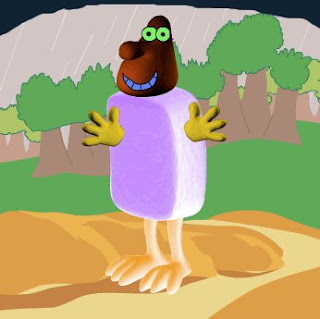For the activity, I printed 25 colour stills taken from the film onto thick board and cut them out. For the first round, the cards were already in order and Aaron placed the cards down as the images passed on screen. I added a bell sound effect over the soundtrack to indicate when an image with a corresponding card passed on the screen. For the second round we mixed up the cards and laid them out. Then on a large black bristol board with boxes traced to fit each card, the cards were placed in order. The video file modified with sound effects and printable scans of the cards are available in the Workshop materials section (coming soon).
After putting away the card game, we went on Aaron's computer to explore some of the excellent interactive animation activities on the NFB Kids website. These little excercies are really fun and intuitive to use. The Fun Stuff section has a variety of different games that allow the user to create a scenario, piece together a character, add sound and bring the story to life. Clay Animation is a good place to start. It lets you create a monster by selecting from different heads, eyes, mouths, bodies, arms and feet. All the different parts can be coloured in, resized, flipped and moved around. Here's the monster Aaron came up with:

STORYBOARDING (or Copy to next!, as Aaron has dubbed it) is the next game we played. Here you initially choose a character , an action and a location. Then the next step is to add the elements, music and dialogue to the first shot and position a virtual camera, then continue he story in the next frame. This is great excise in planning a visual story and in the end you get to play the storyboard you just created. I captured this video of the screen as Aaron worked on his project.
Finally PICTURE THIS brings together elements from both the previous games to make a live action animation. After creating a charcter, you bring it to life by moving all the different parts of its body in a sequence of frames.
Aaron picked up on how to use these interfaces with almost no instruction. Have to give the NFB props for usability (and I take back by previous snipe at their mediocre music, the "Back Porch" soundtrack has a pretty rad riff!) Each of the buttons have an associated sound which Aaron really seems to enjoy as well. I've used this program with another autistic child I work with who is 7 years old and non-verbal. He too really amazed me by how fast he learned to manipulate the different controls. Its unfortunate that these kinds of skills can really go unnoticed because computers have traditionally been such a solitary endevour. This is one amongst many other reasons I think the development of online communities is of such importance today.
We leave you now with Aaron final animation he put together using PictureThis. Enjoy!

Aucun commentaire:
Enregistrer un commentaire